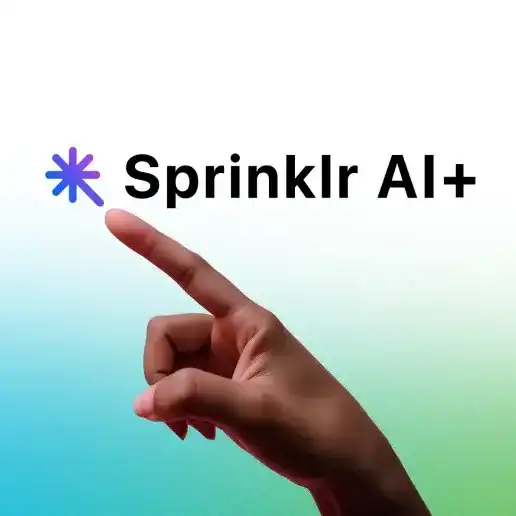The next generation of CCaaS is here
Digital-first customer service, enterprise-scale voice support. Redefine customer service with an AI-powered platform that unifies voice, digital and social channels. Power channel-less interactions and seamless resolution no matter the channel of contact.

How Conversational AI Helps the Telecom Industry
We’re right in the thick of the telecom revolution, and it’s an exciting time to be alive. It's a world full of possibilities, with the market set to boom with 5G networks altering the very fabric of connectivity.
Did you know by the end of 2023, North America was expected to own a whopping 61% of global 5G use? And mobile data traffic could even triple by 2029. That's a lot of streaming and browsing!
Telecom operators are in constant rivalry as the pricing pressure is immense — which pushes them to operate on razor-thin margins. So, standing out in the crowd is not easy. Everyone wants to be the go to choice, but what makes anyone different? A great customer experience. This is where conversational AI in telecom comes into play, giving that needed edge in how we talk and engage with customers.
What is conversational AI?
Conversational AI is a blend of technologies that enable systems to simulate human-like conversations. It uses natural language processing (NLP), machine learning and voice recognition to understand, respond and learn from interactions with users. In an industry where customer satisfaction is key, and switching providers is easy, telecom companies use conversational AI to reduce average hold times and streamline support. This smart tech acts like a support right hand, handling repetitive inquiries and ensuring that each customer feels heard and helped promptly.
5 key benefits of conversational AI in the telecom sector
With the commoditization of telecom services, customer expectations are rising, and so is peer pressure. Telecom companies must stay sharp and innovative. Serving a demanding customer base manually is tough, but conversational AI in telecom makes it much easier. Here are the key benefits of using conversational AI in telco.
1. Real-time resolutions
The telecom ecosystem is huge, with a stipulated global revenue resting at $1.2 trillion in the next six years. It’s simply not feasible to attend to everyone manually. So, what happens when customers have a quick question about their bill or need to update their plan?
Conversational AI handles these everyday questions easily, simplifying your customer service operations and reducing your subscriber churn. This means less time waiting for simple answers and more time for the support team to help with tricky problems.
💡Real-life success story: How Mobily slashed its response times by an incredible 99.6%
Mobily was facing what most telco providers in a market with a big client base face — a flurry of queries from everywhere and no way to attend to them in time. Using conversational AI deployed over all its social pages, Mobily became truly omnichannel — ensuring customers can find answers through AI self-service around the clock. Besides the unbelievable uptick in its first response times (FRT), the network provider also improved its case processing by 68%, from three minutes 55 seconds to one minute 16 seconds, courtesy of omnichannel customer service.

2. Real-time translation
Real-time translation is specifically important in regions with multiple official languages or in international markets. For telecom companies with a global or diverse customer base, conversational AI breaks language barriers. No matter what language your customer speaks, AI can understand and respond, making sure customers feel heard and valued.
3. Improved network reporting
Customers can report service disruptions or poor signal quality directly through conversational AI chatbots and voice bots. The AI can quickly log these issues, detecting problem areas for technical teams to address, leading to faster service restoration and improved network performance.
4. Product personalization
Conversational AI in telecom can analyze a customer's usage and preferences to suggest data plans, international calling options or value-added services that fit their unique needs. So, if your customer loves streaming or travels a lot, it'll recommend options that match their lifestyle, making sure they get the most out of your telecom service.
Watch on-demand: What TikTok and Publicis Sapient Say About Personalization Driving Growth
💡Pro tip: Consider not just what your customers want but what your competitors are doing about it. Sprinklr’s Unified-CXM covers all grounds in the market — with conversational AI that helps you capture the voice of customers and a benchmarking tool that brings insights into your competitors' moves from over 400K social accounts. That’s how you stay two steps a
5. Proactive engagement
You can use conversational AI to give your users a heads-up regarding network updates, downtimes and maintenance windows before they even have to ask. This not only keeps them in the loop but brings in trust, transparency and togetherness in your customer relationships.
Also Read: Tips for a Proactive Customer Service Strategy
How to implement conversational AI for telecommunications
While conversational AI can benefit telecom players manifold, its implementation needs sharp attention and precision. Here are the steps to follow to implement conversational AI in telecommunications.
1. Assess customer touchpoints
Start by analyzing where customers most frequently interact with your services – be it through contact centers, social media or mobile apps. Understand the common queries and issues (contact drivers) reported across customer touchpoints, like billing disputes, plan upgrades/downgrades, network outage reports, etc.
2. Identify what has a high impact
Find out scenarios where AI can particularly improve efficiency, customer satisfaction or both. Focus on situations like assisting customers in emergency credit top-ups, handling sudden loss of service and providing guided troubleshooting for device-specific issues.
💡Did you know: Sprinklr AI+ allows you incisively funnel down your top contact drivers, the top reasons why your customers contact you, create intent buckets and launch AI bots that are ready to handle a wide range of cases reported in natural speech.

3. Collate your niche knowledge
Start building a knowledge base that details support for emerging technologies (like 5G or IoT device connectivity), region-specific service information and step-by-step guides for self-installation of home network equipment. You can equip this knowledge base with AI, so your conversational bots can fetch technical information right away.
4. Train AI with telecom-specific use cases
Feed the AI with real customer interaction data, including transcripts of resolved issues, common complaints and frequent inquiry patterns.
Beyond training it on the basics, it includes diverse cases such as handling outage disruptions, addressing seasonal plan changes (e.g., tourist season-specific plans) and assisting with cybersecurity-related customer concerns (like phishing or scam calls).
5. Conduct pilot-testing
Implement the AI in a live environment within a controlled group. Monitor its performance while:
- Handling high-demand events like new product launches or major service updates
- Managing complaints during annual sale days or festivals
- Handling connectivity issues in remote or rural areas
6. Ensure your AI is holistically compliant
In the telecom industry, adhering to regulatory standards is critical. Make sure your AI system complies with industry-specific regulations, especially concerning customer data privacy and security.
- Ensure AI adheres to data protection laws like GDPR for customer privacy
- Implement strong encryption protocols to protect customer data during AI interactions
- Conduct regular security audits to identify and fix vulnerabilities in the AI system
Interesting Read: How to Use Conversational AI for Customer Service
Use cases of conversational AI in the telecom industry
Now, let’s dive into the practical use cases conversational AI solves in the telecom industry.
1. Automated fault diagnosis
In telecom, when customers encounter network or connectivity issues, conversational AI steps in swiftly. It diagnoses problems based on user input, offering prompt and accurate troubleshooting. Check out how it can help troubleshoot for the customer easily. [image of this chat conversation.
2. Secure bill inquiries and payments
Conversational bots can make this process pretty straightforward. Customers can text a chatbot or use voice commands with conversational IVR to ask about bill details, understand charges and securely make payments on a safe AI interface.
Conversational AI in telecom smoothly links with all sorts of payment methods – bank transfers, digital wallets or card payments — giving users their preferred payment choices. But it gets smarter; the AI keeps track of billing cycles too. Say your customer’s monthly data plan is about to renew – the AI's on it, sending timely reminders and helping with the renewal.
3. Generative AI integration for agent productivity
You probably know how canned responses work, right? Generative AI takes this capability up a notch by crafting well-toned, relevant and accurate responses that agents can send on the go. It can summarize conversations and suggest potential steps — considerably shortening the time it takes for agents to resolve cases.
Also Read: How to Use ChatGPT for Customer Service (+ Prompts)
4. Targeted promotions by segmentation
Conversational AI gathers heaps of data from its regular interactions with telecom users, smartly segmenting customers for targeted promotions and increased customer lifetime value (CLV).
The AI works through the generated insights – finding out who's always using max data, who makes international calls or who sticks to basics.
Then, it pivots its focus on each segment specifically.
For the data-heavy users, it might suggest a promotion with extra gigabytes. For those calling overseas regularly, it offers a special international plan.
Conversational AI mixed in with generative AI can even hyper-personalize these experiences.
Generative AI can nudge agents to smartly tailor international call plans by analyzing where and when customers call. It can suggest plans with better rates for their most-called countries, even including perks like off-peak hour discounts, perfectly aligning with different time zones. This precise, thoughtful approach can make each plan feel custom-made for the user's calling habits.
5. Simplify field appointments
Conversational AI in telecom can go beyond basic calendar coordination for offline service visits. It can find out customers' preferences, technician availability, and even factors in travel time and route optimization to find the best available slots to show the user.
Say a customer needs a home internet setup. The AI not only finds a slot matching the customer's preferred time but also aligns it with the nearest available technician, considering their current workload and location. Such real-time action minimizes waiting times and travel costs.
At the back end, AI can predict potential delays by analyzing real-time traffic data or the technician's progress at previous jobs. It proactively communicates any schedule changes to the customer, maintaining transparency. If a technician finishes early nearby, the AI can suggest rescheduling to an earlier time, maximizing daily appointments and simplifying workforce management (WFM) for your customer service managers.
7 out of 10 top global telecom brands use Sprinklr
We know that as a telecom network, you quite literally have millions of customers to look after. Sprinklr for Telecom is built to do just that, so you can finally take a breather.
Curated to solve use cases specific to your industry, Sprinklr can filter 3.6 million messages a month to detect legitimate customer tickets from irrelevant ones.
While the average first response SLAs in telecom sits at 11 hours, Sprinklr’s conversational AI solution can skillfully bring it down to just 2.5 hours. While this may seem like a lot of talk, we can show it to you for free for 30 days.

Frequently Asked Questions
Conversational AI effectively manages telecom network issues by promptly alerting customers about outages, offering status updates and suggesting immediate troubleshooting steps.
While conversational AI adeptly answers standard technical queries, more intricate telecom issues still require a nuanced understanding of human technical support.
Yes, telecom companies ensure data privacy in AI interactions by employing robust encryption, strict adherence to data protection regulations and transparent data usage policies.



